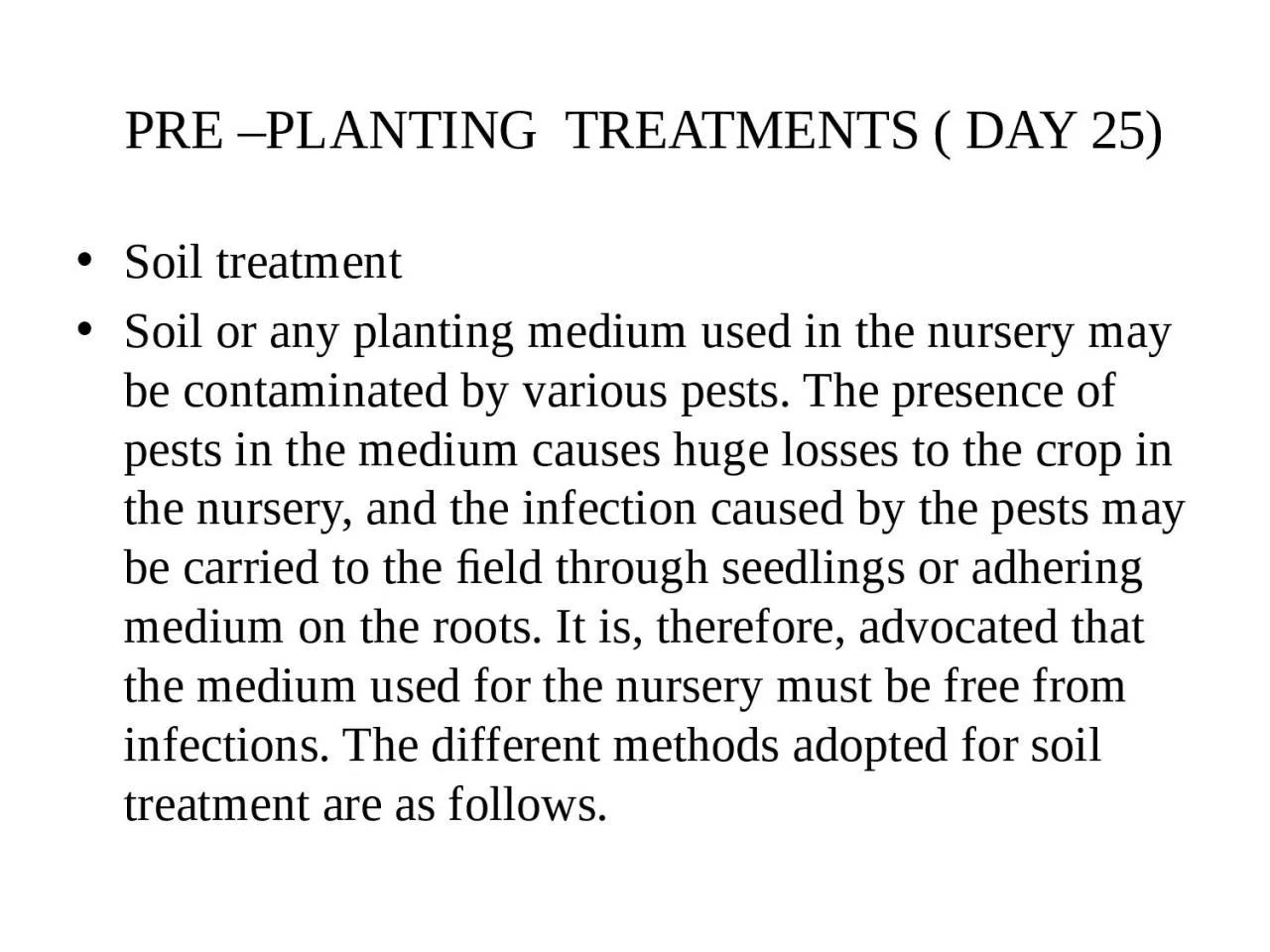

Soil treatment Soil or any planting medium used in the nursery may be contaminated by various pests The presence of pests in the medium causes huge losses to the crop in the nursery and the infection caused by the pests may be carried to the ID: 1048458
Download Presentation The PPT/PDF document "PRE –PLANTING TREATMENTS ( DAY 25)" is the property of its rightful owner. Permission is granted to download and print the materials on this web site for personal, non-commercial use only, and to display it on your personal computer provided you do not modify the materials and that you retain all copyright notices contained in the materials. By downloading content from our website, you accept the terms of this agreement.
1. PRE –PLANTING TREATMENTS ( DAY 25)Soil treatment Soil or any planting medium used in the nursery may be contaminated by various pests. The presence of pests in the medium causes huge losses to the crop in the nursery, and the infection caused by the pests may be carried to the field through seedlings or adhering medium on the roots. It is, therefore, advocated that the medium used for the nursery must be free from infections. The different methods adopted for soil treatment are as follows.
2. It is, therefore, advocated that the medium used for the nursery must be free from infections. The different methods adopted for soil treatment are as follows
3. Soil solarisation It is an environment-friendly method to control soil-borne plant pathogens, including bacteria, fungi, nematodes, insect-pests and weeds. Solar energy increases the temperature of the soil, which helps control various soil-borne pathogens. The most appropriate time for soil solarisation is May−June when the temperature reaches 47 ºC or above. This treatment causes physical, chemical and biological changes in the soil.
4. Formalin solution treatment • Formalin solution is used to sterilise the soil. It is prepared by adding 2.5 ml commercial grade formaldehyde per litre of water and the soil is drenched @ 45 litre of solution per m2 to saturate the top soil surface up to a depth of 15–20 cm. • The drenched area is covered with a polythene sheet of 200 gauge so that the fumes of formalin penetrate into the soil to kill the pathogens.
5. The polythene cover is removed after 48 hours. • The soil is raked so that the fumes of formaldehyde gas escape from it. If poly-house, soil is treated with formalin, the doors and side covers of the poly-house must be opened to allow formaldehyde gas to escape. • The bed is kept open for 7–10 days prior to seed sowing. It must be ensured that there are no fumes of formaldehyde gas prior to seed sowing.
6. Soil treatment by fungicide • Fungicides like captan or thiram @ 5 g/m2 are used to control soil-borne pathogens. • These fungicides can also be used as soil drench by preparing a solution of 2.5−3 per cent and drenching @ 4−5 litre/m2. Soil treatment by insecticide Insecticide, such as chloropyriphos @ 2 ml/litre of water is applied to a depth of 15−20 cm in the soil to kill insects, including ants, white ants and their eggs, nematodes, etc.
7. Use of bio-agents • Certain biological agents like trichoderma are used to control soil-borne pathogens. • Bio-agents @ 10–25 g/m2 are mixed in the soil, and after 2–3 days, the seeds are sown.